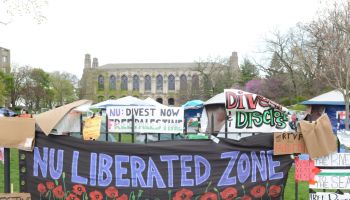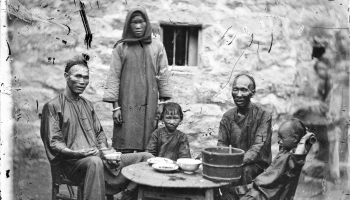“Savvy.”
That was the word used in a recent Gothamist article to praise members of the Hasidim, or strict Orthodox Jews, in New York’s Williamsburg, Brooklyn for taking advantage of the city’s subsidized housing voucher program, raising questions about why people of color who use entitlements are considered malingerers, while Whites are praised as enterprising.
The Gothamist piece explores the Williamsburg Hasidic community’s ability to secure a vast majority of the city’s Section 8 vouchers in the once poor community that has become a real estate hotbed after years of gentrification. Section 8 vouchers are government assisted subsidies where the tenant pays 30 percent of their rent and the government voucher covers the rest.
With access to a plethora of resources, it’s evident why this pocket of New York’s Hasidic community has acquired placement in the coveted neighborhood of Williamsburg, which spans over the East River and offers sweeping views of Manhattan’s jagged skyline.
On that note, Queens College professor Samuel Heilman uses “savvy” in Gothamist to describe the Hasidim, saying,“These are people who are poor, but they’re not beaten down. They’re savvy,” he said. “They’ve figured out a way to live with poverty, but not to be impoverished. That’s the extraordinary story.”
A report by the UJA-Federation and the Met Council says about 55 percent of Hasidic households in NYC live below the federal poverty line.
New York’s history of gentrification, political gerrymandering, and economic inflation make affordable housing a knotty issue, and greatly affects communities of color, specifically Blacks and Latinos in comparison to Whites. According to an American Fact Finder Survey, 19.9 percent of Black families live below the poverty line, compared to 26.7 percent of Hispanics in the Empire State. About 11.4 percent of Whites live below the poverty line.
A joint study by the New York Daily News and WNYC found in 2000, there were 1,394 vouchers in the nine Yiddish-speaking tracts of Williamsburg. By 2014, there were 12 Yiddish tracts that had over 3,000 vouchers. Yiddish is the language spoken by the Hasidic Jewish community.
The New York City Housing Authority reports New York City has the largest applicant pool of Section 8 housing in the country, with a total of 599,493 residents served by NYCHA’s programs. The agency provided numbers (pdf) showing 52 percent of Whites received vouchers as opposed to Blacks at 42 percent.
Even as the nation recovers slowly from the housing collapse, low-income residents across New York City are finding upward mobility difficult. Due to a lack of economic opportunities, some minorities on the voucher program simply cannot rally to “pull themselves up by the bootstraps,” a plight echoed by adversaries of the Section 8 program.
Alana Semuls, a reporter for The Atlantic, documented the toils of subsidized housing in a piece written last summer. In it, she notes the history of Section 8, a program first created to help families gain access to neighborhoods they were shut out of; places devoid of the constant threat of violence, neighborhoods where their children would have access to stellar education, offering further social and economic advancement.
Semuls writes:
“For example, in much of the country, landlords can refuse to take Section 8 vouchers, even if the voucher covers the rent. And, unlike the landlords in poor neighborhoods in Eva Rosen’s study, many landlords of buildings in nicer neighborhoods will do anything to keep voucher-holders out. The result is that Section 8 traps families in the poorest neighborhoods.”
But there are vocal critics who argue that Section 8 housing enables tenants, interlocking them into complacency.
Howard Husack, a contributing editor at the City Journal, takes a stab at explaining why suspending Section 8 vouchers is necessary in his May 16 article, “Let’s End Housing Vouchers.” When discussing the initial intention of vouchers – integrating Whites and Blacks in middle class neighborhoods – Husack says the following:
“Racial integration is hard enough when Whites and Blacks are at relatively similar incomes,” he writes. “Mixing poverty-level blacks—by design of the Section 8 program—with middle-class Whites is a recipe for racial instability.”
He offers a solution on what can replace Section 8 vouchers instead of what’s currently in play: create “institutional homes” for families that places fixed time limits on habitation. Capping his argument that social and economic stability would improve if we as a society encouraged parental training and marriage for women who run single-parent households.
Heilman and others seek to convey that Hasidim, faced with increasing economic challenges, was able to prevail by using political connections to zone areas ripe for local developers to build as needed. Real estate focused groups like the United Jewish Organization helped Hasidic residents in Williamsburg to fill out voucher applications in bulk – Gothamist writes UJO once assisted 2,000 people to apply in a single day.
Indeed, Williamsburg’s Hasidic community deserves applause for their housing enterprise, but it’s important to note that for some minority communities, mobilizing is hard when the engine needs to be replaced. Do you agree? Sound off in the comments.
SOURCES: Gothamist, NYCHA, The Atlantic, New York Daily News, WNYC, U.S. Census Bureau, UJA-Federation, City Journal | PHOTO CREDIT: Getty
SEE ALSO:
North Carolina Airbnb Host Banned After Racist Messages Exposed
























